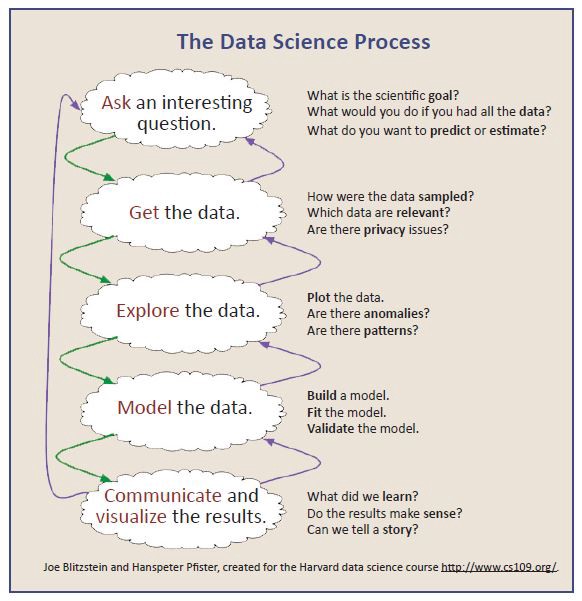To ask the right question is already half the solution to a problem

There is a bad joke out there that a data scientist is someone who is very successful at solving the wrong business problems. This is due to many projects that data scientists and analysts undertake which do not necessarily deliver any business value.
It’s often easy for data analysts and data scientists to be carried away by fancy algorithms and start “forcing” business problems to be solved by the algorithm even if by solving the problem there will be no tangible business value. The quality of the insights you get from the analysis is greatly influenced by the quality of questions you ask. Asking the right question about the data and the business processes often leads to the right approaches for analyzing your data.
Asking questions helps you fit into your stakeholder’s shoes and understand the business problem they want to solve. Questions are a good way of assessing your stakeholder’s motivations and financial interests. But truth be told, it’s not as easy to get to that one right question that will give you all the insights you need to drive some form of decisions in the business. What you can do, you can start by asking lots and lots of questions. when you have a good grasp of the business, ask more direct questions to understand what your stakeholders want to solve. Now you have a few questions to concentrate on. Analyze them or discuss them with the stakeholders until you get to “the” question(s).
Mastering the art of asking questions is an invaluable skill to have for data-related professions. By raising many questions, you are able to filter the most significant question which shapes the course and impact of your analytics project. In this blog, we shall look into 5 levels of questions that should act as a guide when undertaking an analytics project
1. What is the problem am trying to solve?
This might sound obvious but many data analysts are quick to dive deep into data projects without a clear understanding of the underlying problem or expected results. Successful data analytics projects begin with an understanding of the problem the business is trying to solve. This is the stage where domain knowledge of the business comes in handy.
Sitting down to frame the business problem you are trying to solve places your project on the right course. Using the adjectives referred to by the famous S.M.A.R.T acronym can set you on the same page as your stakeholders.
2. Which metrics will define my success?
As the old adage goes “What can be measured can be improved”. This question helps you know the indicators that will define the direction and success of your analytics project.
This question helps to decide on which metrics and KPIs should be measured, how they should be measured, and what would be success indicators?
For instance, if you are running an analysis for call center data you can choose to measure the “average speed of answer” as a metric to define the performance of each agent. You can decide to set a threshold of an ideal spread to answer and measure the agents that fall below and above the thresholds as success indicators.
3. What data do I need?
After you have all the metrics you need for the project, the next set of questions revolves around which data you will need for the metrics. Analyzing the most important metrics before embarking on a data search makes your search for relevant data direct and focused.
In this phase, it’s important to write down a set of all variables you will need. Then ask if the data is available and indicate the source of it. Some you get by querying the database, some you might need to scrap from the web. Whichever the source, it’s important to know what’s available and what’s not. For the data that is not available, you indicate how you can get it and the process that will be involved.
Another set of questions to ask together with the data needed is the question of the accuracy and quality of your data. If it is a sample dataset, is it a true representation of the population you will be inferring to? Remember clean data always beats fancy algorithms.
4. What statistical analysis and visualization will you need to apply?
At this point, you are already clear about the problem you are intending to solve, the metrics you will be measuring and the data you will need. Now, you assess which statistical methods will work best in analyzing your data? and which models will you need to build? For EDA(Exploratory Data Analysis) which graphs will work best in visualizing your trends and uncovering patterns? Which tools will be used to clean and analyze the data?
A trick you can use to cub this question is to write down the visualization type and analysis method you need next for each metric you intend to measure. if you want to show a metric and compare categories, choose a bar graph. Line graphs work best for time series analysis. Scatter plots are best to show the relationship between two numeric variables e.g Age and salary. Pie charts are good to show proportions of categories that add up to 100%. Pie charts are recommended only when you have categories less than 5.
5. How will you communicate the results to the key stakeholders?
The epitome of a successful analytics project is the effectiveness of results communication to the stakeholders. After the analysis, you want to communicate your results to the stakeholders in a way that will make them feel a certain way and take certain decisions. It’s important to ask a set of questions about the best strategy to use when sharing your results with the stakeholders?
Other questions that can help shape the way you present your results would be; What actions will be taken from the results of my analysis? What would be the cost of implementation of my recommendations? Are my results controversial to the business norms? what level of resistance am I expecting?

Conclusion
All through the analytics project, you need to ask questions and filter the ones that you think answering will provide great insights. Being a curious cat and skeptical about your data is a skill that will often make you to uncover trends and insights that lie beyond the surface. Nobody is interested to know what they already know. The trick to getting good at asking excellent data questions is to keep on asking them.
“If I had an hour to solve a problem and my life depended on the solution, I would spend the first 55 minutes determining the proper question to ask… for once I know the proper question, I could solve the problem in less than five minutes.”
Albert Einstein
